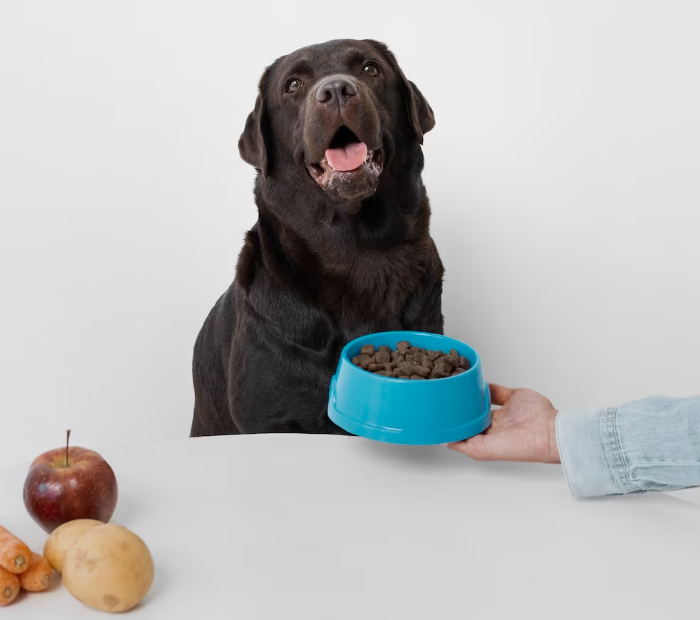2024-02-12
Sweet, spicy, salty, vegan...when it comes to food, we all have our own tastes and choose our food to suit our nutritional needs, dynamic lifestyle, and also to make us feel good! Sticking to a healthy food routine is a daily practice for some people, while for others, it is a task almost impossible to achieve!
When it comes to our beloved paw friends, we should be careful and considerate of the food we feed them. This is not only because some foods are toxic for dogs (e.g. xylitol, cacao, raisins) but also because we should strive to provide our pets with the best possible living conditions and make sure they will live healthy and happy lives.
Proper transition from puppy food to adult dog food is an important element of maintaining optimal nutrition levels. While puppyhood is a period of growth and development that requires specific food to support the process, adulthood is a different life stage related to its own nutrition requirements. Feeding your furry friend the right nutrition at each life stage is crucial for their overall health and well-being.
Here comes the question- When should you stop feeding your dog puppy food and transition to adult dog food? Let’s find out!

Dogs reach physical maturity at different ages, based on their size. While small and medium-sized dogs are considered physically mature at the age of 8-9 months, up to 1 year, large dogs need a longer time to fully grow- up to 2-3 years.
For instance, if you have a Yorkshire Terrier (Yorkie), they will be considered adults between 9-12 months of age but if you have chosen a dog such as the Great Dane as your paw friend, then they will be considered adults between 18-24 months of age.
You should observe your pup’s growth and adapt their diet accordingly.
Despite all the unified characteristics within the same breed, dogs remain individuals.
You should monitor your pup’s development and adapt their nutrition properly.
You should pay close attention to your dog’s weight and make sure they are developing properly. Make sure they have a healthy weight- neither skinny nor overweight.
There is an easy way to tell if your paw friend’s weight is healthy or not: Locate their ribs and spine. If your dog is underweight, the ribs and spine will be overly noticeable; on the other hand, if they are hardly visible, as well as the waist, then your dog might be overweight.
A healthy weight means a clear waistline and a spine and ribs that are not visible but can be felt easily by touch.
A dog’s weight can be used as an indicator of when a transition from one type of food to another one might be needed.
Some dog breeds are naturally more active than others, e.g. the Golden Retriever, the Australian Shepherd (Aussie), the Border Collie, the Jack Russel Terrier, etc.
Highly energetic dogs have different nutrition needs compared with canines who lead a rather sedentary life. You should consider your paw friend’s activity level when deciding what type of food would be most suitable for them.
For instance, dogs with low energy levels should not be fed food rich in fat, as they are more prone to gain weight.
Last but not least, you should take your dog’s health condition into account. If there are any health issues your paw friend is dealing with, they will definitely affect their nutrition needs.
If this is the case, consultation with a veterinarian is highly recommended. They will make a diagnosis and recommend proper treatment and diet that will best suit your dog’s needs.

Transitioning from one type of food to another, should not be done at once. Any abrupt changes in your dog’s diet may cause digestive issues, or worsen any current digestive problems your dog might be having. Furthermore, dogs are sensitive creatures who respond to any changes in their environment. Sudden changes in the diet may lead to emotional imbalance in our paw friends.
The best way to proceed is to gradually add new food by starting with very small amounts. There is a common rule that many professionals follow, namely that 10% of the new food should be mixed to the current one until it reaches 100% of the content.
For example, on the first day of the transition, you should add 10% new food, on the second day- 20% new food, on the third day- 30%, and so on.
A gradual transition will enable you to monitor how your dog’s response to the new food. If your paw friend remains active and happy and you do not notice any changes in their behavior or symptoms such as diarrhea or vomiting, then you are on the right track.
On the other hand, if there are any side effects or abnormalities such as irregular bowel movement, inconsistent stool, lethargy, fatigue, swollen abdomen, etc. you should talk to a veterinarian immediately and consider a different diet or food brand.
The number of meals per day depends on your dog’s age.
-Puppies up to 6 months old are usually fed three to four times a day;
-Teen dogs between 6 and 12 months old are typically fed two to three times a day;
-Dogs who are 1 year old or older are usually fed twice a day.
Having said that, transitioning to adult dog food is also accompanied by reducing the meals per day. If your paw friend is highly food motivated and reducing the number of meals seems to be difficult, then you still can divide them into several portions throughout the day by reducing the amount.
Alternatively, your veterinarian may recommend a specific brand or type of food allowing you to maintain the same number of meals without your dog gaining weight.
The breed characteristics and the specific dog’s needs should always be considered.
It is advisable to observe your dog in the oncoming months right after the transition, even if they respond well to the new food.
This is needed, in case you notice they are under/overweight, and adjustments in the diet are needed.
Putting your paw friend on a balanced diet seems to be the best thing to do in terms of meeting their nutrition needs.
Many dogs prefer wet food over dry food as it is often more aromatic and flavorful than dry kibble. The strong scent and moist texture can make it more appealing to dogs with a strong sense of smell and taste. Also, wet food has a higher water content than dry food, which makes it a good choice for dogs with low water intake.
However, many veterinarians recommend that owners do not exclude dry food from their canines’ diets.
Dry food helps promote chewing and reduces the buildup of plaque and tartar. Along with its dental health benefits, dry food is used for maintaining nutritional balance. Also, it is easier to store and lasts much longer once it is opened.
Some dog owners prefer to put their paw partners on a raw food diet. While it has many benefits, it can also have disadvantages, so consulting with a veterinarian first is recommended.
Chewing on raw bones will help your canine maintain their oral hygiene. Also, there are many proteins and important fatty acids in raw food, which are beneficial for dog coats and skin. Decreased risk of certain health conditions and digestive problems along with reportedly higher energy levels are among the other advantages of a raw food diet.
However, raw food may not be suitable for all dogs. It can cause nutritional imbalances, especially if not introduced correctly, and also increase the risk of bacterial contamination. Last but not least, a choking hazard is a real risk that should not be taken lightly.
Knowing when and how to transition from puppy food to adult dog food is essential for ensuring your dog’s overall well-being. Always keep in mind that each dog is an individual, and factors such as breed, size, weight, and overall health should be taken into consideration. Providing the right nutrition at the right time ensures that your beloved paw friend will lead a happy and healthy life.